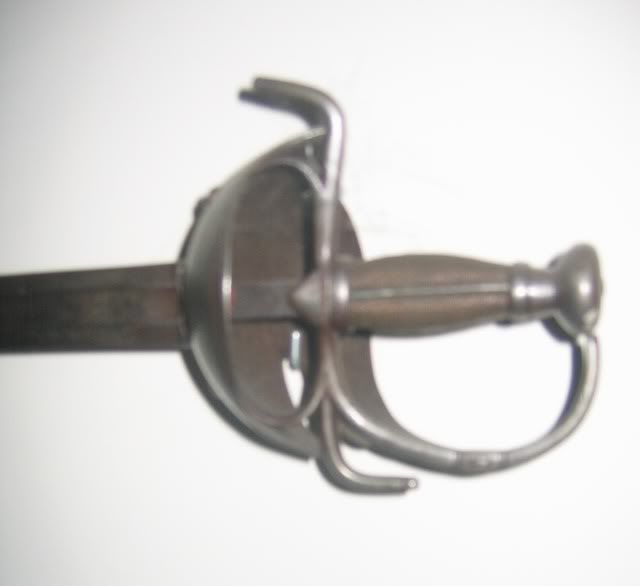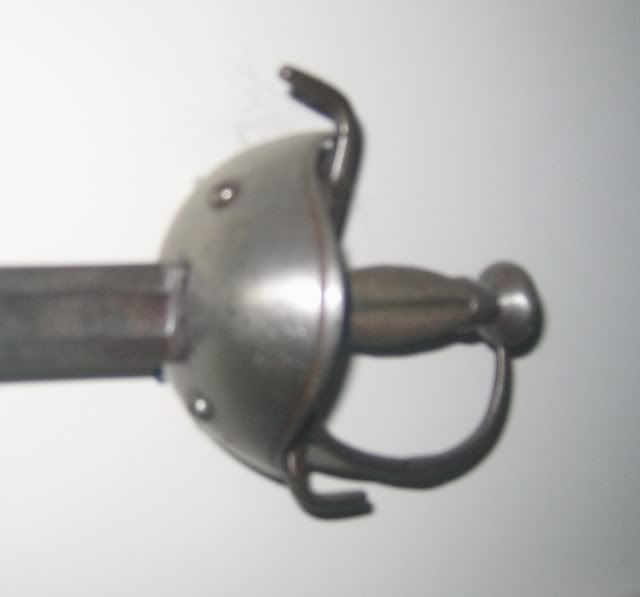
 |
|
|
#1 |
|
Member
Join Date: Sep 2008
Location: PR, USA
Posts: 679
|
FYE
Spanish, German, English or Italian..? : ) Manuel Luis       
|
|
|

|
|
|
#2 |
|
Arms Historian
Join Date: Dec 2004
Location: Route 66
Posts: 10,730
|
Hi Manuel Luis, and welcome to the forum, and what an outstanding entry with this extremely interesting rapier!
I was completely drawn in by this unusual hilt, and spent some enjoyable time trying to see what I could come up with. Actually, the characteristics of this rapier hilt seem most closely aligned to the well known 'Spanish' cuphilt of the 17th century, in the cup form guard, wide quillons, and the adjoined knucklebow which does not meet the pommel. The hilt overall seems closest to #101 in the late A.V.B.Norman's "The Rapier and Smallsword 1460-1820" (London, 1980, p.179) which is a deep cupped guard (without rompepuntas) c. late 17th c.+ It is noted that Spanish cuphilts were worn in the Low Countries, and that a hilt of this sort was made for a visit from a Swedish dignitary in 1655. While not specifying if this style hilt was for either of these instances clearly, the author does note further that, "...the cups of these hilts have lobated edges with rays emerging from the center to meet at the junctions of the lobes along the edge of the cup. In some cases the 'petals' thus formed are as few as eight or as many as twenty". It seems that similar type hilts are noted c.1675 in Madrid ("Compendio de los Fundamentos" of Francisco de Ettenhard, plate VII) and in Venice in "La Spada Maestra" of Bondi di Mazo (1696). The blade seems to correspond with latter 17th century 'trade' blades that were actually from Solingen for the Spanish market and were traded and into the 18th century to Spains colonies in my understanding. The characteristic 'anchor' type stamp is known to have appeared on early Toledo blades (such as on those marked to Alonso Perez, one of which was found on the wreck of the 'Atocha, sunk in 1622 off Florida coast). The German makers often applied spurious Spanish names and marks, the X's were often used in these blades inscriptions, and the ENT may have been En Toledo? These notes are what I found with resources at hand, and of course Manuel, I would like to know if these observations might concur with your opinions on this rapier. Thank you so much for posting this !!!  All very best regards, Jim P.S. I'm completely baffled by the crosshatched pommel, and quillon terminals en suite, which don't seem to correspond to anything in the hilts shown in 'Norman" (op.cit.) or other references I checked. |
|
|

|
|
|
#3 |
|
Member
Join Date: Sep 2008
Location: PR, USA
Posts: 679
|
Geez, what a gaffe! No wonder it didn't look exactly right. What is inscribed on the blade is actually "ENT FECIT", not "En Toledo"..!
Thanks for gentlemanly letting me realize my blunder, Jim. : ) Gracias also for the time you took researching this blade. My suspicion is that its a Solingen job, made in the spanish style, late 17th century. Spanish cup guards were huge affairs. This seems to be a smaller german-italian late model, just prior to the advent of the tiny-by-comparison shell-guards of small-swords. I suspect it could be Italian precisely becacuse of the intrincatedly carved quillons, albeit spanish swords of the pricier kind were also characterized by this very same feature... Best regards Manuel luis |
|
|

|
|
|
#4 |
|
Member
Join Date: Sep 2008
Location: PR, USA
Posts: 679
|
Another two hilts with similar size characteristics.
|
|
|

|
|
|
#5 |
|
Arms Historian
Join Date: Dec 2004
Location: Route 66
Posts: 10,730
|
It seems that Solingen from these times really has thrown us some curves! I recall how astonishing it was to realize after years of admiring those 18th century Spanish 'dragoon' broadsword blades so often seen on Spanish colonial swords, and discovering that they were Solingen products sent to the colonies for mounting. These Solingen rapier blades were also part of the inventory it seems. I have one with this same cross section with 'Jesus' on one side and 'Maria' on the other, and a spurious Toledo stamp, much in the fashion of the 'anchor' on this one.
All of these are the more fascinating to me with my deep interest in the Spanish colonial weapons. These other two rapiers you have posted are beautiful as well, I cannot ever see enough of these kinds of examples. All the best, Jim |
|
|

|
|
|
#6 | |
|
Member
Join Date: Sep 2008
Location: PR, USA
Posts: 679
|
Howdy Jim,
I'm not really sure these full-stops were anchors, although they do look similar. To me they look more like a mount topped by a cross, sometimes two, one right above the other. Mount Calvary, perhaps? I have read somewhere that others actually see a in it primitive dog figure, with raised tail. Which could point to the so-called "Wolf-of-Passau", also used by Solingen, but which truly was a copy of the famous 15th C. Spanish armourer "Maestro Perrillo" (Julian something) trade's mark. In any case, this full-stop was used both in Solingen and Toledo blades. Which doesn't help pinpoint manufacture origins. Here we have in some Museums deposits a bewildering array of precious blades mated to plain, beaten up cup-guards and hilts. Obviously a later combination, not done by the blade-smith. Take care! Manuel Luis Quote:
|
|
|
|

|
|
|
#7 |
|
Member
Join Date: Feb 2005
Posts: 296
|
Here are a couple of pictures of a "Snail shell" hilt. The blade is etched, double edged and very worn. I don't see too many of these around.
 
|
|
|

|
|
|
#8 |
|
Member
Join Date: Sep 2008
Location: PR, USA
Posts: 679
|
Nice M1796!
: ) |
|
|

|
|
|
#9 |
|
Member
Join Date: Dec 2004
Location: Orlando
Posts: 104
|
Ed
Here is another one. The blade is original the hilt has been added. I was working in Spain in 1975 and 1976 and picked up the blade in Toledo. This lead me to making up this array based on the city's Coat of Arms. Mick |
|
|

|
|
|
#10 |
|
Member
Join Date: Sep 2008
Location: PR, USA
Posts: 679
|
Holy Cow!
What beauties! The perfect combination, an M1728 and an M1796... I'm envious... : ) BTW: I'm using the same wood carved shield to show a couple of my swords... |
|
|

|
|
|
#11 |
|
Member
Join Date: Dec 2004
Location: Madrid / Barcelona
Posts: 256
|
Beautiful couple

|
|
|

|
 |
|
|